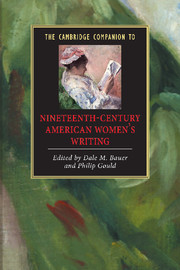Book contents
- Frontmatter
- Introduction
- Part I Historical and theoretical background
- Part 2 Genre, tradition, and innovation
- 4 Captivity and the literary imagination
- 5 Nineteenth-century American women's poetry
- 6 Women at war
- 7 Women, anti-Catholicism, and narrative in nineteenth-century America
- 8 Immigration and assimilation in nineteenth-century US women's writing
- Part 3 Case studies
- Conclusion
- Index
8 - Immigration and assimilation in nineteenth-century US women's writing
from Part 2 - Genre, tradition, and innovation
Published online by Cambridge University Press: 28 May 2006
- Frontmatter
- Introduction
- Part I Historical and theoretical background
- Part 2 Genre, tradition, and innovation
- 4 Captivity and the literary imagination
- 5 Nineteenth-century American women's poetry
- 6 Women at war
- 7 Women, anti-Catholicism, and narrative in nineteenth-century America
- 8 Immigration and assimilation in nineteenth-century US women's writing
- Part 3 Case studies
- Conclusion
- Index
Summary
Lamenting the discrepancy between her vision and her experience of America, the young protagonist of Russian immigrant Anzia Yezierska's short story “How I Found America” seeks out her sister's teacher as a potential confidante. She pours out the story of her immigration from Russia and of her disappointment at the hardship and poverty, but most of all at the loneliness and alienation she has experienced in the New World. She is amazed at the depth of understanding manifested by this “born American,” whose ancestors came over on the Mayflower. The teacher, bemused by the intense young girl's amazement, reminds her that “The Pilgrim Fathers” were themselves “immigrants two hundred years ago,” and she goes on to quote the words of celebrated man of letters Waldo Frank: “We go forth all to seek America. And in the seeking we create her. In the quality of our search shall be the nature of the America that we create.” In the exchange, the protagonist believes that she has “found the soul - the spirit - of America!” (Yezierska, “How I Found America,” 297).
If the questing protagonist of the story did not quite find the soul and spirit of America, she had at least discovered a dominant theme of immigrant stories – some written by immigrants, but many by the numerous public figures and settlement workers who wished to legislate immigrant policy and to define, in order to shape, “the immigrant experience.” The theme would be picked up and institutionalized subsequently by many historians of immigration in the second half of the twentieth century, who argued that the immigrant experience was central to – and even constituted – America and that each generation of immigrants reinvigorated the spirit of the nation.
- Type
- Chapter
- Information
- Publisher: Cambridge University PressPrint publication year: 2001
- 1
- Cited by



